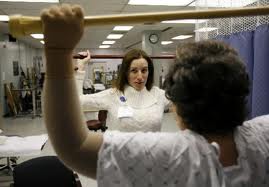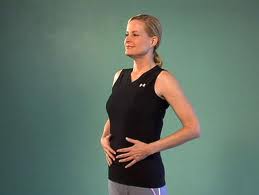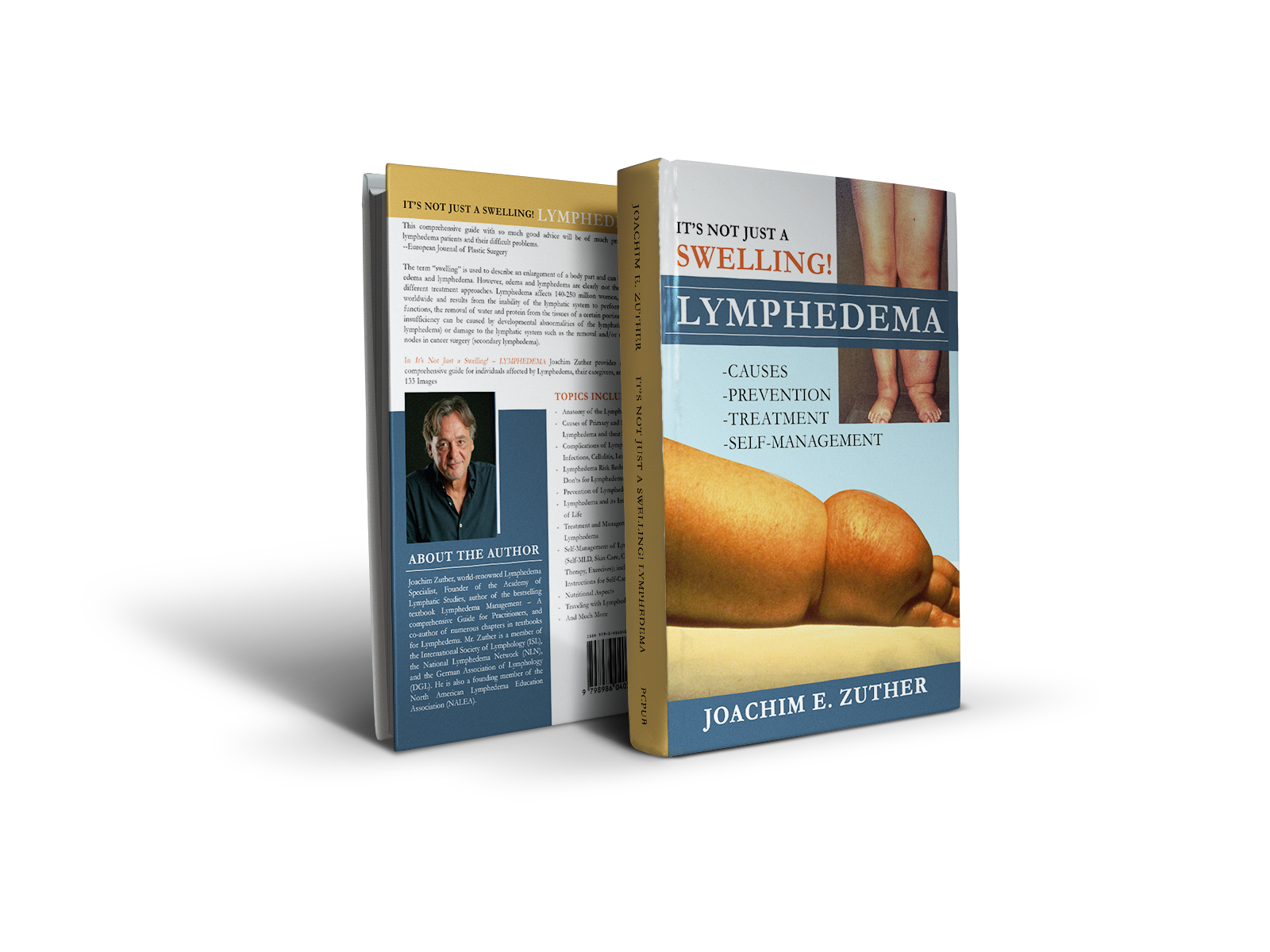Unlike the heart in the blood circulatory system, the lymphatic system does not have an active pump to propel lymphatic fluid back to the bloodstream. Effective lymph flow depends on sufficient muscle and joint activity, especially if the functionality of the lymphatic system is compromised. Decongestive exercises are most effective if performed while the patient wears compression garments or bandages, which are also essential components in lymphedema management. Ideally, decongestive exercise protocols are performed two to three times daily for about 10-15 minutes, and the patient should rest with the affected limb elevated for at least 10 minutes following the exercises.
These active, non-resistive and repetitive exercise protocols should be customized by the lymphedema therapist and/or physician to meet individual goals for patients affected by lymphedema. The stage and type of lymphedema, specific restrictions and limitations of joint and muscle activity, as well as additional medical conditions need to be considered.
customized by the lymphedema therapist and/or physician to meet individual goals for patients affected by lymphedema. The stage and type of lymphedema, specific restrictions and limitations of joint and muscle activity, as well as additional medical conditions need to be considered.
Breathing Exercises
 The downward and upward movement of the diaphragm in deep abdominal breathing is an essential component for the sufficient return of lymphatic fluid back to the bloodstream. Patients affected by lymphedema of the leg benefit greatly from an exercise program including diaphragmatic breathing exercises; however, abdominal breathing exercises are also beneficial for patients affected by lymphedema of the arm. The movement of the diaphragm, combined with the outward and inward movements of the abdomen, ribcage, and lower back, also promotes general well-being, peristalsis and return of venous blood back to the heart.
The downward and upward movement of the diaphragm in deep abdominal breathing is an essential component for the sufficient return of lymphatic fluid back to the bloodstream. Patients affected by lymphedema of the leg benefit greatly from an exercise program including diaphragmatic breathing exercises; however, abdominal breathing exercises are also beneficial for patients affected by lymphedema of the arm. The movement of the diaphragm, combined with the outward and inward movements of the abdomen, ribcage, and lower back, also promotes general well-being, peristalsis and return of venous blood back to the heart.
Following are sample decongestive exercise protocols, combined with breathing exercises for the upper and lower extremity, which are published in the book “It’s Not Just a Swelling! Lymphedema”. This book also contains self-MLD and self-bandaging protocols for patients affected by lymphedema. The exercise protocols below serve as guidelines and the movements outlined must not cause discomfort, pain, or soreness.
Before you engage in any exercise program, especially if you have additional medical conditions, please make sure to get your physicians approval.
Decongestive Exercises for the Upper Extremity
- Exercises should be performed wearing compression bandages or compression sleeves (except when exercises are performed in the water)
- Tight or restrictive clothing (tight underwear or bra, heavy breast prosthesis) should not be worn while performing the exercises.
- Exercises should be performed twice daily for about 10-15 minutes. The duration of the program should be slowly increased over a comfortable period of time.
- Movements should be performed in a slow and controlled manner, and the musculature should be relaxed between each individual exercise. The relaxation phase should last at least as long as the time spent during the exercise.
Exercises are performed sitting on stool or a chair without leaning back. Many of the exercises however may be performed lying on the floor. Proper breathing techniques should be used throughout the session.
Abdominal Breathing (3 repetitions)
Place both hands on your belly
Inhale deeply through your nose into your belly (feel how you breathe against your hands)
Exhale through your mouth
Perform breathing exercises as often as possible during the day
Neck Exercises (2-3 repetitions each)
Turn your head slowly and look to the right as far as possible; return to normal position; repeat on the left side
Bend your head to the right and try to touch the shoulder with your ear (do not shrug your shoulder). Return to the starting position and repeat for left side
Shoulder Exercises
“Shoulder Rolls” (3-5 repetitions each)
Rotate shoulders alternately on the right and left side.
Perform shoulder rolls using both shoulders forwards and backwards
“Shoulder Shrug” (3-5 repetitions each)
Shrug both shoulders and inhale. Exhale while the shoulders relax
Arm Exercises (3-5 repetitions each)
Fingers
Place palms and fingers together
Move little fingers away from each other and back together
Move ring fingers away from each other and back together
Continue with each finger
Alternate position:
Hold palms out in front of the body with the palms facing up
Move thumb and index finger together, so the finger pads touch each other, return to open hand
Move thumb and ring finger together, so the finger pads touch each other, return to open hand
Continue with each finger
Hand
Alternate between hands, the relaxed hand rests on the leg
Make a fist and hold for about three seconds
Open the fist and relax the hand for about three seconds
Make a fist and rotate the wrist clock wise and counter-clockwise
Make a fist and touch it to the opposite shoulder
Arm and Hands
“Picking Oranges”
Stretch out arm and lean forward
Make a fist and return hand to leg
“Climb up the Ladder”
Alternate between arms and continue for about 30-40 seconds
Hold arms above head
Grasp rungs of imaginary ladder and “climb” as high as possible (remain seated)
“Swimming”
Use breaststrokes as far as possible to the front, move arms to the side, then to the knees and to the front again
“Push Hand to Opposite Knee” (Alternate between arms)
Place the palm of one hand on opposite knee and push down with hand, and upward with knee
Hold for five seconds
Exercises with a Broomstick (3-5 repetitions each)
“Climb up and down the stick”
Hold the stick vertically between your knees with your hands
Take the stick at bottom with one hand and walk up and down the stick with alternating hands
“Weight Lifting”
Hold the stick with both hands horizontally with the palms up
Lift the stick up and towards your head and return to original position
“Wringing the Stick”
Hold the stick with both hands horizontally with the palms down and about one foot apart
Attempt to wring the stick moving one hand forward and the other back
Hold for about 3-5 seconds and wring in the other direction
“Canoeing”
Hold the stick with both hands horizontally with the palms down and about one foot apart
Start to paddle to either side with nice and big strokes
Decongestive Exercises for the Lower Extremity
- Exercises should be performed wearing compression bandages or compression garments (except when exercises are performed in the water)
- Tight or restrictive clothing should not be worn while performing the exercises
- Exercises should be performed twice daily for about 10-15 minutes. The duration of the program should be increased slowly over a comfortable period of time
- Movements should be performed in a slow and controlled manner, and the musculature should be relaxed between each individual exercise. The relaxation phase should last at least as long as the time spent during the exercise
Exercises should be performed lying supine on the floor, preferably on a cushioned mat or other surface that maintains some firmness. Proper breathing techniques should be used throughout the session. To avoid back strain, a small pillow may be placed under the knees
Abdominal Breathing (3 repetitions)
Place both hands on your belly
Inhale deeply through your nose into your belly (feel how you breathe against your hands)
Exhale through your mouth
Perform breathing exercises as often as possible during the day
Foot and Leg Exercises (3-5 repetitions each)
Toe Clenches (either alternating or with both feet at the same time)
Curl your toes and squeeze for about three seconds
Relax the toes for three seconds
Spread the Toes (either alternating or with both feet at the same time)
Spread the toes as far as possible and hold for about three seconds
Relax the toes for about three seconds
Ankle Curls (either alternating or with both feet at the same time)
Flex the foot as far as possible at the ankle with the toes pointing away from the body (back of the knee remains on the floor)
Hold for about three seconds
Flex the foot as far as possible at the ankle with the toes pointing to the shin
Relax for about three seconds
Ankle Rotation (either alternating or with both feet at the same time)
Rotate foot at the ankle, clockwise and counter-clockwise
“Riding the Bike” (for about one minute)
Lying on your back, move legs in the air as if riding a bicycle
(If you use a stationary bike, keep it on a low setting to avoid soreness or strain)
Heel Sliding
Move the heel of your foot as close as possible to your buttocks
Return to starting position and alternate the leg
Hand and Knee Touch
Lift one knee and push the palm of the opposite hand against knee. Hold for about three seconds
Relax for about three seconds and alternate sides
Butt Lift
Bend the knees and place your feet flat on the floor
Raise your buttocks off the floor and hold for about three seconds
Bring the buttocks back to the floor and relax for about three seconds
Walking
Walking is a great exercise for lymphedema of the lower extremities and can be easily performed while you walk your dog around the block (if you have one). If you use a Stairmaster or treadmill, keep it on a low setting to avoid soreness or strain.
Remember to always try to walk with a normal gait. Do not drag the affected leg and avoid limping.
Additional Resources:
Stretching exercises – video
Arm Exercises (examples) – video
Arm Exercises with a Wand (examples) – video
Leg Exercises (examples) – video
Dear Lymphedema Blog Reader – if you like the contents on this website, please help to keep it going. A great amount of work and research is necessary to provide you with up-to-date information on this site. Your donation supports these efforts and associated administrative costs. Surplus funds will be donated to Lymphedema/Lipedema-related charitable endeavors. Please donate using the “Donate Now” button on the right upper hand of this page – Thank You!
Join Lymphedema Guru, a Facebook page solely dedicated to informing about all things related to lymphedema – news, support groups, treatment centers, and much more


 Joachim Zuther, Lymphedema Specialist.
Joachim Zuther, Lymphedema Specialist. 

Joe,
Would you be willing to allow us to publish some of your work in our newsletter and/or on our website here in British Columbia, Canada? Everything you’ve sent has been great so far and it’s so appreciated the work you put into your articles and the quality of them.
Lynn Holloway
BC Lymphedema Association
Dear Lynn:
Please let me know which articles you would be interested in.
I LOVE THIS BLOG!!! I APPRECIATE THE CLEAR AND CONCISE AND HIGHLY EFFECTIVE ADVICE. THIS CONVENIENCE IS IMMEASURABLE. THANK YOU AGAIN FOR ALL YOURE DOING.
Thank you! Your blog is so patient centered and helpful and these exercises are wonderful. Thank you for generously sharing your knowledge.
Thanks again! You have the most informative blog out there on lymphedema. Thanks for the detailed descriptions of the exercises.
Thank you for making this available. Will put to good use.
To all of my Lyphedema friends,
Being a patient we all know how expensive therapy treatments can be. I have been fortunate enough to have a good insurance company. I have changed lymphedema pumps 3 times. If anyone out there needs a pump, I have 2 that I will sell for only what I paid in deductible. This will save someone a ton of money. If you are interested please email me @ mturse@hotmail.com with the subject line as “pump” and I will email you details.
Sincerely,
Matt T.
[…] Decongestive and Breathing Exercises for Lymphedema […]
Decongestive exercises in elastic garments are certainly helpful, however, they last for a short period of time and most patients, especially with edema after mastectomy,” spare” their limb afterwards not using it for normal activities. The whole effort is lost. We strongly advice to do home weight lifting (5-8kg) flexing in elbow then brachial joints and trying to put the weight of the top of the head. This procedures should be repated several times a day. We didn’t observe any inflammatory complications like (dermato-lymphangio-adenitis, DLA). Movements in brachial joint become easy. Edema decreases. The compression sleeve should gradually be changed to a tighter one. This is of course costly. From the point of view of lymph and edema fluid hydraulics, new tissue channels (not lymphatics) should form from the upper arm to the trunk. This can be seen on lymphoscintigraphy. We changed the term “decongestive exercise” to ” decongestive behavior”. This means the swollen limb should remain highly active all the time.
re Dr. Waldemar L. Olszewski MD comments of January 22, 2011:
I am interested in additional detailed description (or research) of the exercises Dr. Olszewski refers to regarding brachial joint movement exercises using 5-8kg weights which could result in new tissue channels (not lymphatics) being formed from the upper arm to the trunk. I have been doing strength training since 2004 (upper limb lymphedema since 1998) and would like to discuss this with my physiotherapist and my personal trainer. Further details from Dr. Olszewski would be appreciated.
Thank you for your comment. I will forward your message to Prof. Olszewsky and hope he will respond to you.
Thank you.
Kirki
I just found out I have lymphedema. Docter say there’s nothing I can do about it. I have it in my legs/ankles/feet. Have just been reading your exercise advice and will follow that, hope it helps.
Dear Marike:
There is certainly therapy available to treat lymphedema – I would suggest to consult with a trained lymphedema therapist. In order to locate a therapist in your area, please go to the “Find a Therapist” link in the menu bar on top.
Mr. Luther, I know I am probably in the minority, but I have lymphedema on the left side of my face and neck due to a lateral neck dissection. It seems like there is only info. for arms and legs. Some of the info can be applied but I was wondering if you know of or have any info. specific for the head and neck. Thank you so much.
Dear Linda – may I refer you to Lymphedema People – there is information on head and neck lymphedema: http://www.lymphedemapeople.com/thesite/lymphedema_of_the_neck.htm
I have had lymphedema for over 30 years, but in the last five years have lost most of use of left hand because of RIBP. Thank you for these exercises–is it ever too late to exercise?? But am giving it a try. I”m almost 76 years of age but healthy and active and would like to get some use of the hand back.
can you have lymphedema under your eyes? I seem to have ‘bags’ of fluid there, sometimes it’s hard to ‘look over the wall’.
It is possible but unlikely
[…] following exercises are from LymphedemaBlog.com – all credit goes to Joachim Zuther, Lymphedema […]
[…] week on my Facebook page, I posted an article from a fabulous blog I’d recently found. The author of the blog is Joachim Zuther, a lymphedema specialist who started […]
Abdominal breathing exercises saved my husband’s life, literally! His COPD (CHRONIC OBSTRUCTIVE PULMINARY DISORDER) was so bad that his physician finally told him to do pursed lip breathing 5 times a day. After 10 days, his breathing improved, and 8 weeks later he is breathing well enough to enjoy his golf and get outdoors again.
[…] Decongestive & Breathing Exercises It is widely recognized as the gold-standard for the treatment of lymphedema and is listed on the web sites of the American Cancer Society (ACS), the National Cancer Institute (NCI), the International Society of Lymphology (ISL), and the National Lymphedema Network (NLN). Skin & Nail Care Skin and nail care are crucial in the line of defense against infections. Lymphedematous tissues are saturated with protein-rich fluid and any break in the skin allows bacteria and other pathogens access to this ideal nutrient source. With this in mind, the skin should always be protected using a lotion that is fragrance free, hypo-allergenic, and has good moisturizing qualities, and should be in either the neutral or acidic range of the pH scale (around pH 5). The pH of a lotion is not typically listed on the bottle but it can be determined by contacting the company. Some examples of appropriate lotions are: […]
Thank you, Thank you, Thank you. Been searching like a mad woman since diagnosed with diagnosed with Lymphedema. My therapist mentioned the name Zuther blog and my search came to a hault. I check it every day. One thing I am curious about. Why are compression garments not lined with a smoother material as it can be irritating to the skin. Especially the gloves which I tend to pull at when my fingers feel restricted which can irritate the skin. There is a bandage (acts like saran wrap which helps) but but love some kind of inner glove like silk. Does anyone else have this problem or know if there is a remedy. Thanks.
After 10 years of abdominal lymphedema, my body seems to be in a disruptive crisis. I had two unrelated cancer surgeries that included deep digging and removal of lymph glands (1)both sides of groin and then 2) both underarms) five months apart. There was minimal extremity retention but my belly would inflate and deflate
For the past month I am getting very poor sleep due to being awaken to the need to urinate every 30-60 minutes. Clear and copius amounts but difficult to initiate. Enourmous relief once accomplished (requiring tap on etc) but then it repeats all nite long. During the day time, when upright, everything seems normal. Not getting understandable medical support or even interest. And directions you can offer would be greatlt appreciated.
Dear Erin: In this case I am not able to give specific advice and would like to ask you consulting with a physician specializing in lymphedema. Here is a link to a list of MD’s specializing in lymphedema
http://www.lymphedemapeople.com/phpBB3/viewtopic.php?f=25&t=5
hi
When I exercise or walk in the morning my legs burn like they are on fire. I scream with the pain. GP gave me Gabapentin. It works but I am still getting some pain and exercise is important as I am trying to increase my fitness on a weightloss programme.
Hi Joe,
Have a patient with lower body lymphedema due to endometrial cancer, surgery including pelvic node resection. Since wearing compression garments,having issues with ingrown hair, causing irritation and may be at cause for a recent bout of cellulitis.
Tried to let hair grown and this only increased the rate of ingrown hair, tried waxing and inquiring now about laser for hair removal.
I lean toward trial of the laser versus shaving, depillatory creams or waxing.
Have you had experience with the use of laser for this?
Safety?
Thanks,appreciate your feedback.
Anne
Dear Anne: Unfortunately there is no research available in laser hair removal with lymphedema. However, based on the possible contraindications associated with hair removal (http://www.lymphedemapeople.com/phpBB3/viewtopic.php?f=10&t=93), I would not recommnd it.
Hi there,
I am a physiotherapist in New Zealand and we have a patient who has had an excision right tongue, neck (level I-IV) and reconstruction using a left forearm flap. She also had removal of the nodes on the right. She has resultant facial and neck lymphedema which we are trying to find the best management for. Do you have any suggestions, especially seeing as she no longer has nodes on the effected side.
Kind Regards
Sarah Drum
Dear Sarah: I would strongly recommend to obtain the 3rd edition of “Lymphedema Management”, which contains an extensive chapter on head and neck lymphedema including treatment sequences, bandaging options, etc. Overall resource http://www.breastcancer.org/treatment/lymphedema/treatments/
I’m gone to convey my little brother, that he should also go to see
this webpage on regular basis to get updated from
newest information.
Hi, I have ahistory of 5 ys. of massive breast cancer on the right side. Have had only natural treatments (Vit.C IVs, silver IVs, nutritional therapy, etc.). There is a lot of lymph activity around the right breast. Since last autumn, the left breast has had lymph activity too, and now the left breast is very heavy and has obvious lymph edema (with indentations etc.) and is much larger than the right one which has shrunk a lot. Any suggestions for specific natural self treatments, please? Thank you.
I would suggest seeing a certified lymphedema therapist to reduce the swelling you are experiencing – in order to locate a therapist, click on the “find a Therapist” button on the top menu bar. You may also try some self-MLD: https://www.lymphedemablog.com/2013/01/08/self-manual-lymph-drainage-for-lymphedema-affecting-the-arm/
[…] week on my Facebook page, I posted an article from a fabulous blog I’d recently found. The author of the blog is Joachim Zuther, a lymphedema specialist who started […]
I suffer from truncal lymphedema. Do you have any suggestions for this area of the body? I am unable to wear a chest compression garment as they are too restricting and cause the secondary neuropathy to flare up. I see my Lymphedema PT every two weeks and have for a almost a year. I cannot imagine what my life would be like if I couldn’t have regular MLD. Any feedback or information is greatly appreciated. Thank you.
It is difficult to control trunkal swelling without compressive wear, such as sports bra or compression vest. Self-MLD in these areas wpuld certainly be helpful
Bilateral legs, pelvic, female genital Lymphedema –
1) 37 lymph nodes removed, radiation & chemo treatment for cervical cancer (six years ago)
2) 3 inguinal lymph nodes removed (due to Angiomyomatous hamartoma and associated stromal lesions in the right & left side inguinal lymph nodes, two years ago)
3) huge amount of excess skin in the upper thigh, hip, & buttocks region
After inguinal nodes were removed – upper leg, genital & pelvic Lymphedema presented
itself immediately & have not been able to control the pelvic & genital (especially), leg lymohedema.
The excess skin make hamper compression garments to be effective, now disfiguring is an issue. Fluid pools from leg in pelvic, genital, hips region.
Would a full pant pump machines be helpful?
Would surgery to remove excess skin impede lymphatic flowor make lymphedema worse ?
Do you have any suggestions?
Thank you
Dear Jo: I would highly suggest you contact a certified lymphedema therapist – you can use the link on top of this page labeled “Find a Therapist” to locate a clinician in your area. Intermittent pneumatic compression pumps may be beneficial in your situation, however, these devices should not be used without complete decongestive therapy (CDT) and proper instruction on the use. Your question regarding the surgical removal of excess skin should be directed to a plastic surgeon knowledgeable in this area. May I suggest Dr. Jay Granzow (http://manhattanbeachplasticsurgery.com/)